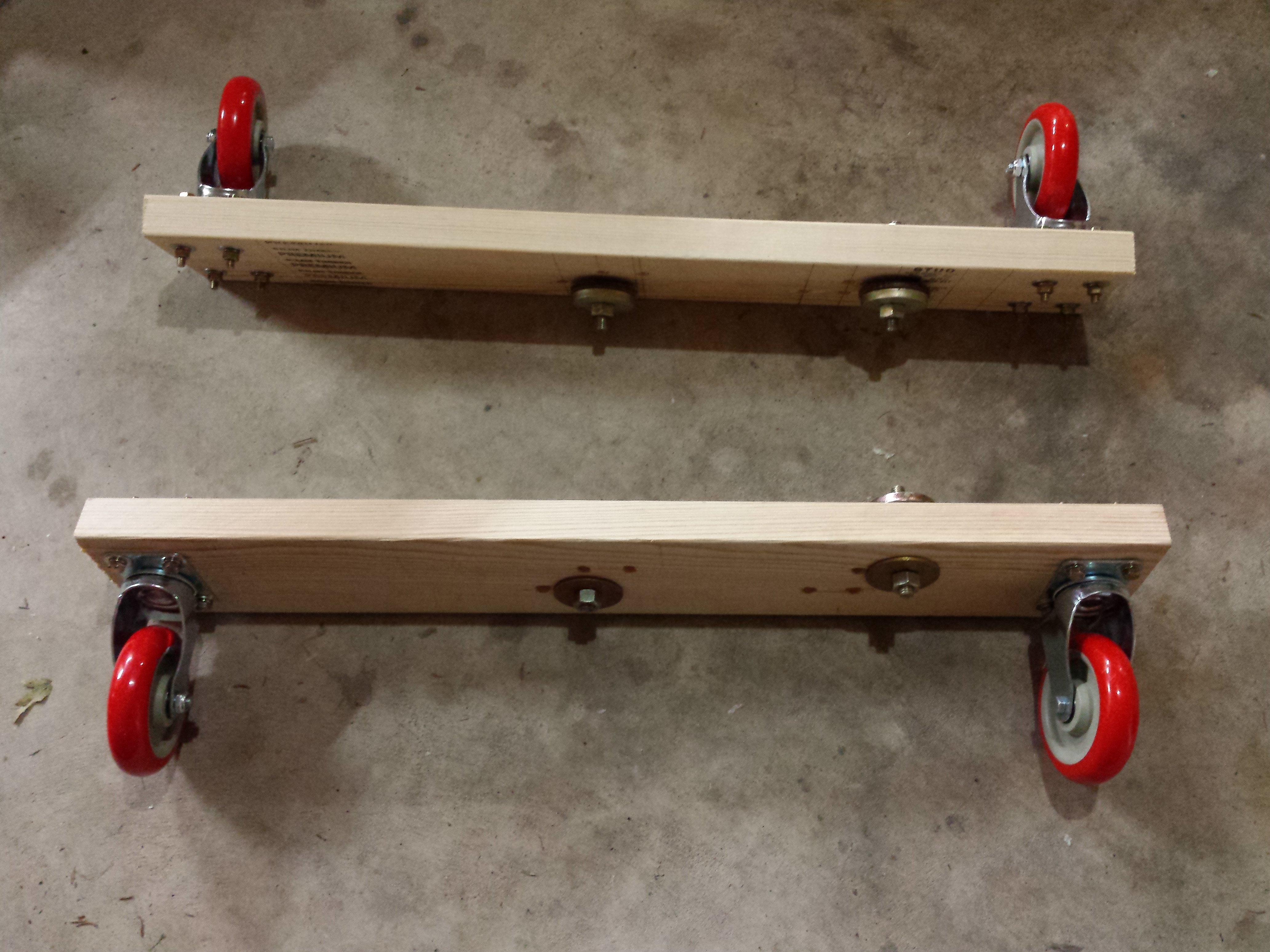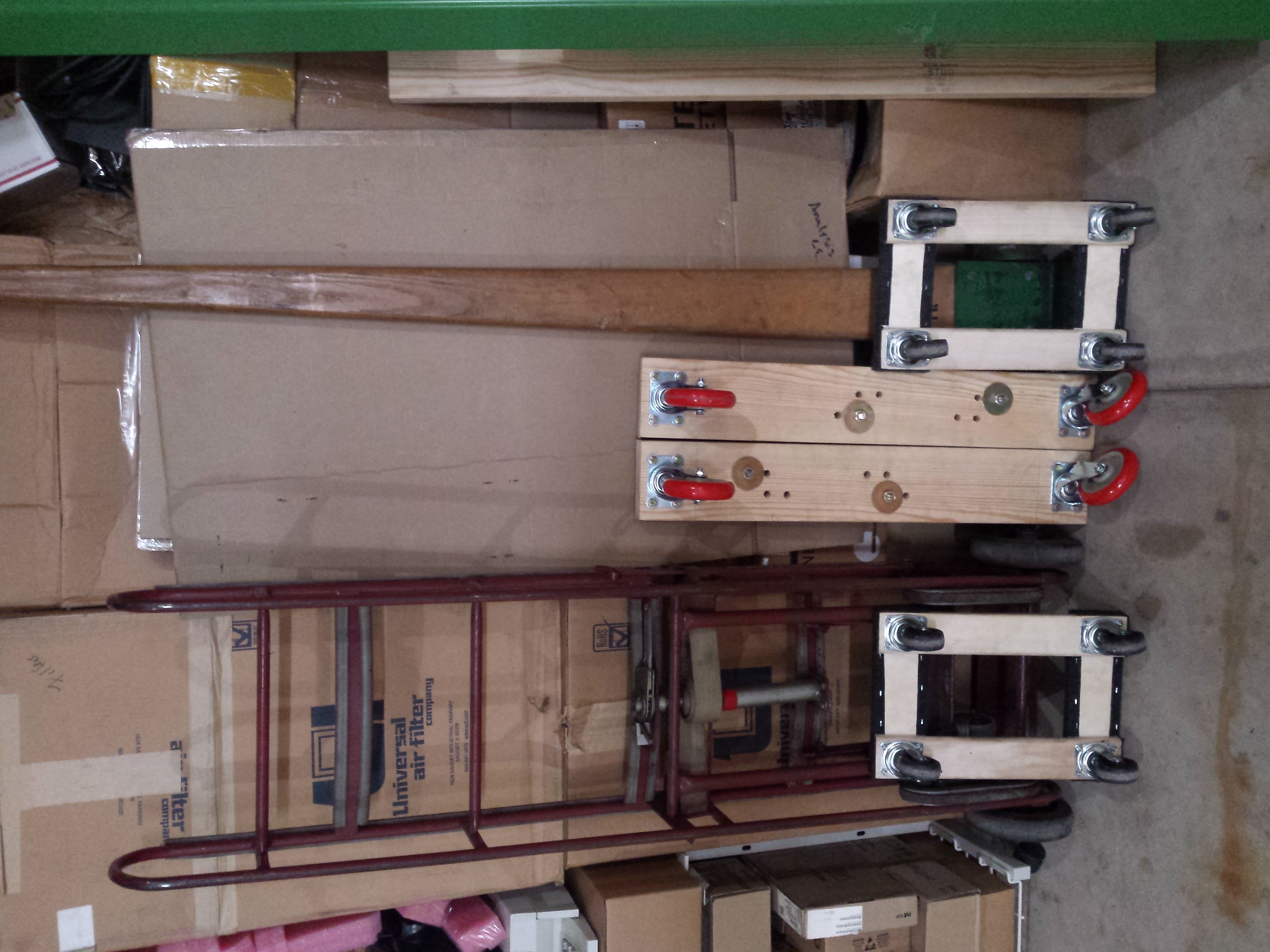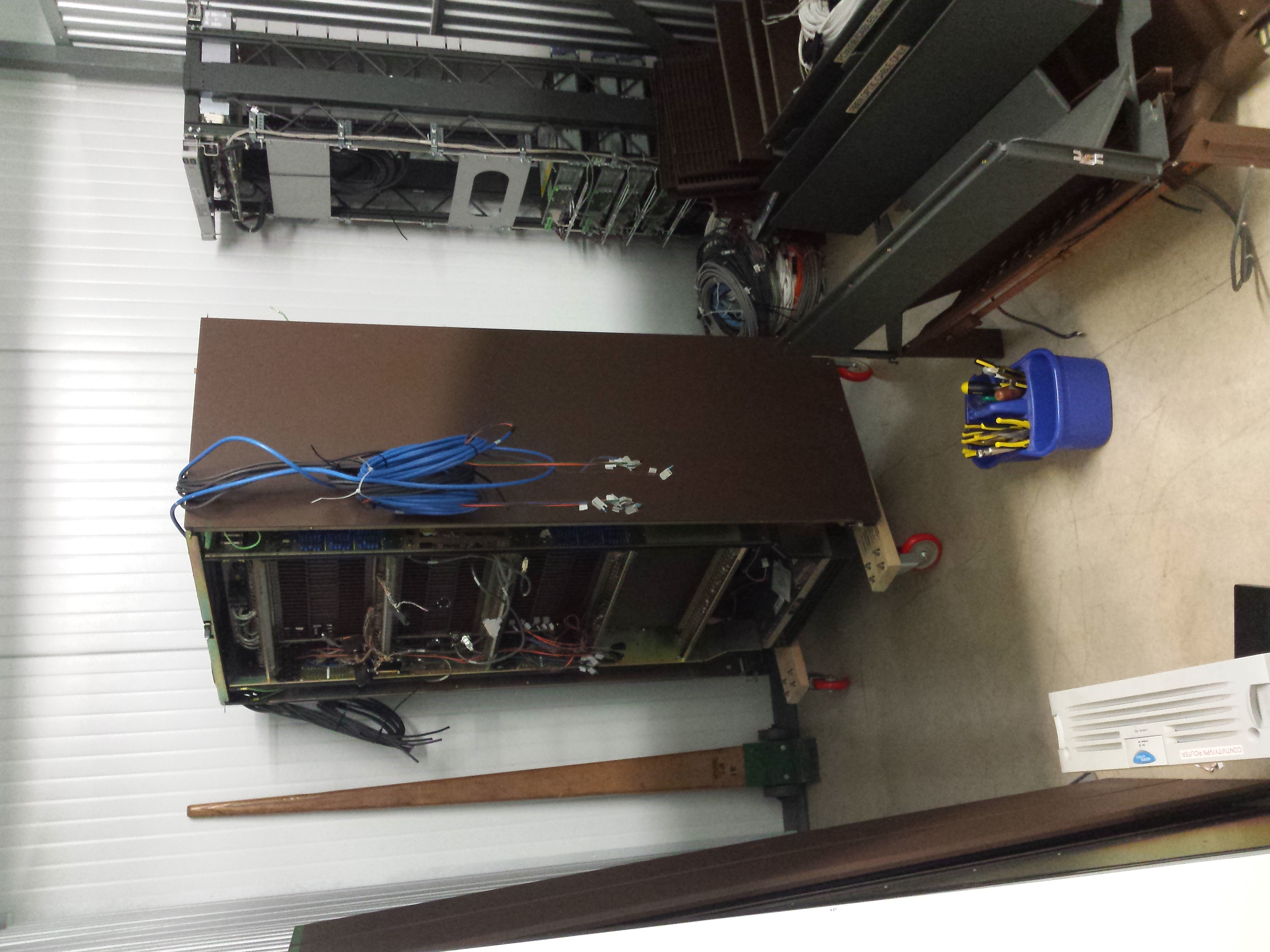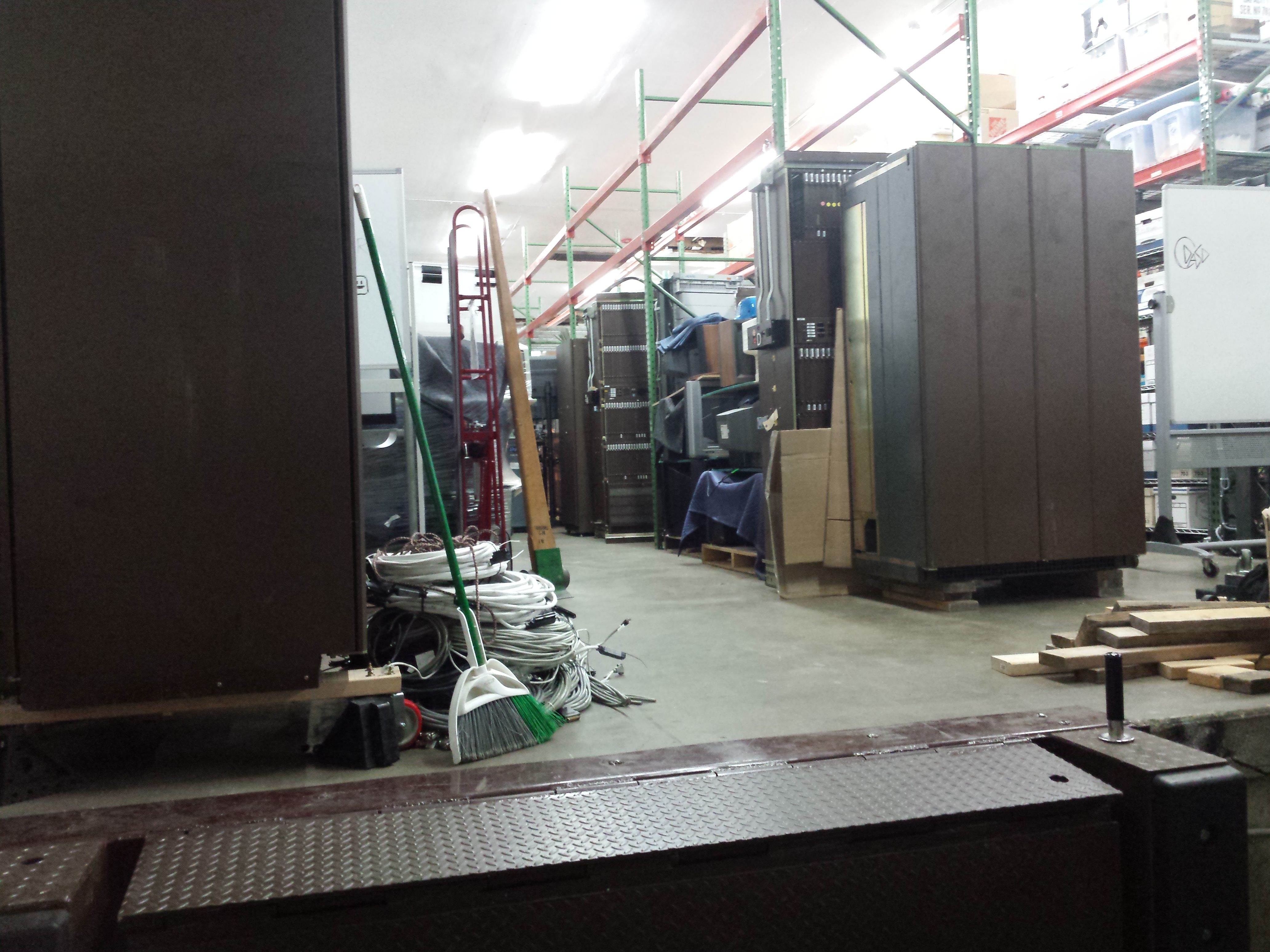Back in part 1 we left off with 13 SL-100 frames and cabinets stored in Alabama. From there, I was busy for about a year between VCFMW, reorganizing the house and the garage, work, and helping some friends out with their warehouse (a bit more on that later).
Over the course of that year, I also thought a lot about overcoming various hurdles to getting the switch home from storage. The biggest one was getting heavy equipment frames up into the back of a truck without a liftgate and unloading at the other end. Nobody seems to do one-way rentals with liftgates, so that was out of the question.
Aside from that, I'd have to coordinate between several helpers again and the optimal way to conduct the move based on all the constraints.
Around May of 2022, I really started focusing again on preparing to move the SL-100. There were a number of preparations to make before I began to coordinate the move itself.
For one thing, I knew I had to come up with a better way to move the 42" cabinets than a couple '1000lb' harbor freight mover's dollies. While it got the job done last time, it was a chore to get those rolling with so much weight on them.
I tried (unsuccessfully) for a while to purchase some machinery movers from someone on craigslist. These are a lot like piano dollies, but a lot stronger and with hydraulic lifting. I eventually gave up on these given the unresponsiveness of the seller and began working on an alternate plan.
Armed with some Nortel drawings of the hole pattern on the bottom of the cabinet, I started designing some skates. They were a simple design, two pieces of 2x6 lumber with holes drilled in the right places to mount to the bottom of the cabinet. I reused the floor mounting hardware that came out of the switchroom to mount them. At each end, I attached some appropriately rated casters chosen carefully to be as large as possible while still being short enough to get under the cabinet utilizing my lever dolly/Johnson bar. I also paid special attention to ensure the resulting cabinet height once the skates were attached was still low enough to make it through a 7ft door.

I also spent many nights assisting some friends with organizing their warehouse and installing pallet racking. This was not entirely charitable, as I had a vested interest in one thing: using their loading dock to unload the truck!
Next up was getting a trailer hitch receiver for my car. I didn't have the whole move planned yet, but I was pretty sure at least some leg of the trip would involve trailering the frames for a short distance. It took about me a weekend covered in rust and sweat under the rear end of my Crown Victoria and I had a brand new hitch receiver installed. Some time after, I also purchased a used chain hoist since I figured I would need some help getting cabinets and frames pulled up a ramp into a trailer when it came to that.
At this point, I shifted my focus to the issue of lifting frames into the truck.
I could rent a forklift, but I had serious concerns about being allowed to use it at the storage units. I didn't really doubt that I could figure out how to operate one, but I'd have a harder time convincing anyone else that they should let me use it at their facility. I also had not one but two storage units I needed to empty, and I had no way to move a forklift between the two locations.
The alternative I came up with was a manually operated material lift (sometimes called a duct lift).
I figured I'd have less of an issue using this at the storage units, and it was also made to be moved in the back of a truck with just one or two people. A quick check of the Sunbelt rentals website showed a 1000lb capacity model available to rent, which I figured should do the job.
With most of the big hurdles accounted for, I started asking around to see who was available to help. By this point it was early July and I knew I wanted to give sufficient buffer to recover before VCFMW in September. If I didn't get the move done by early August, it was most likely wasn't going to happen until October.
I finally got enough people together around the end of July. One college friend local to Chicago, an IRC friend who would drive from Texax, and a VCF MW friend local to Alabama would be joining me to assist. The move itself would be between August 10th (the start of the drive down) and August 14th (unloading and returning the truck).
I would be taking half of Wednesday the 10th off. After I finished work that day, I would pick up a one way rental car from Chicago to Nashville. I had to rent the car because I didn't have anyone local who was willing to drive my car back for 12+ hours in one day. Furthermore, I ended up having to rent from O'Hare International Airport and drop off at Nashville International Airport because of the relatively short notice to reserve the car.
After picking up the car, I would load all the tools and supplies I thought I'd need. Then I would proceed to pick up the local friend and continue on our way to Effingham, IL where we would spend the night.
The next morning, we would continue to Nashville where we would would pick up the 22' box truck I had reserved, transfer the contents of the car to the truck, drop the car off at the airport, and then continue on our way to Tuscaloosa. We would meet up with the other two members of our party, who were driving separately, once we were there.
That night, we'd do our best to prepare one of the storage units for moving the next day. We wouldn't be able to actually load the truck without the material lift, but that wouldn't stop us from putting the 42" MCNI cabinet on the skates. We could also work on reducing the weight of the 42" cabinet by removing the card shelves.
That brings us to the material lift. It turned out that the 1000lb capacity model wasn't actually available and had been removed from the Sunbelt website. Instead I ended up reserving a 650lb capacity model from United Rentals. However, this meant there was no chance of moving the two 42" cabinets without significantly reducing the weight. My calculated estimates for the completely empty cabinets still worked out to several hundred pounds.
We'd be picking up the material lift Friday morning, and then loading the first couple of frames and cabinets at the first storage unit. Once that storage unit was emptied, we'd move to the second one and focus on moving as many frames and cabinets as we could until the material lift needed to be returned at 5PM.
After that, we would move anything left in the storage unit that we could into the truck and head back to the hotel to sleep.
If necessary, we could do a bit more loading Saturday morning, but the intention was to leave for the Chicago area if all went well. It would take the entire day to drive back, then I would drop off my friend at his house and go to sleep.
Sunday morning, I would clear out all the smaller items I could move on my own from the truck into my garage. Afterwards, I would take the truck to the warehouse to unload the heavy frames and cabinets using the loading dock. The equipment would be stored there temporarily, and then trailered to my house over the weeks leading up to VCF MW.
August 10th, mostly everything went to plan with the only exception being that I didn't manage to fit my appliance hand truck in the car. I figured I wouldn't actually need it, and I got everything else that was important loaded without issue.

By the time we made it to Effingham, we were right on schedule.
The next morning, we continued to Nashville without any major events.
At the truck rental location, my friend was a bit surprised at the size of the truck I had rented. He wasn't expecting something so industrial.
We had to contend with some rain before we got everything moved from the car to the truck, then we continued to the airport to drop off the car.
Continuing on towards Tuscaloosa in the box truck, the driving remained uneventful.
We checked in to the hotel, moved some things into the room, and continued to the first storage unit where ultimately met with the other two members of our party.
The first order of business was to shuffle the MCNI away from the wall and get the skates under it. This went smoothly, with the only complication being that several trips ended up being necessary to actually get all the tools out of the truck that were needed. The holes lined up, we had no issue getting the skates into place, and the skates worked much better than the harbor freight dollies.

It wasn't immediately clear to us how the shelf assemblies came out of the cabinet. At first it looked like there would be dozens of difficult to reach screws that needed to be removed. We decided to take the screws out of the front of the shelves and see if we could get them to move. Ultimately it turned out that the shelves were separate from the cable management pieces meaning that only the 4 front screws were holding each shelf in.
After undoing all the power and data cables from the rear, we were confident the shelves could be removed the next morning for loading, and we returned to the hotel for the night.
In the morning, I picked up the material lift from the rental place and brought it to the first storage unit.
We worked on getting the MCNI cabinet into the elevator down to the first floor, and out to the truck.
For the sake of saving work, we tried to see if the lift could pick up the cabinet with the shelves still installed. We ultimately decided that this was not going to work based on how much the lift was flexing.
After taking the shelves out, we managed to get the lift under the cabinet and started lifting with the other people stabilizing it as it went up. Once it was high enough, we pushed it into the truck, let it down carefully, and pulled the lift out.
After getting the cabinet in place, we replaced the shelves, removed the skates, and maneuvered it into position against the wall of the truck to secure.
The OAM cabinet was next. We tilted it down on it's side to get it out of the storage unit since it was 7' tall. From there, it was wheeled out to the lift and the truck on harbor freight dollies. We shifted it onto the lift and lifted it into the truck where we righted it and strapped it to the wall.
After clearing out some cabling left in the storage unit, it was empty and we moved over to the other unit.
At the other unit, we had to shift a number of smaller loose items out of the way first, and then we went straight to working on the 42" DPCX cabinet.
Loading this cabinet basically went the same as the MCNI did, and before long it was in the truck. The other 7ft frames we began loading like we did with the OAM cabinet.
After a break for lunch, and more loading, we were down to about 3 or 4 cabinets and about an hour before we had to return the lift at 5pm. We got down to two cabinets before we loaded the lift into the truck and I left to return it.
Knowing we were cutting it close on dropping off the lift, I had the person with me call ahead to let the rental place know we'd be coming in soon. I also had them navigate so I could focus on driving.
We pulled into the rental lot a few minutes before 5pm. I immediately opened up the back and set to unloading the lift. One of the rental employees looked inside the truck and exclaimed "Hol-eee shit" upon seeing that the truck was nearly full of large equipment cabinets. They started locking up and closed the exit gate behind us after we left.
Once back at the storage unit, I was prepared to declare that we were done loading cabinets since we no longer had the lift. However, the others were determined to finish the job.
Since we didn't have the lift, I went with someone else to Harbor Freight to procure a hand truck of sufficient weight capacity while the other two continued loading what they could into the truck.
The remaining two cabinets were the CSF21 and the PT2K, which hold the CompactPCI chassis and the Nortel ethernet switches respectively. We determined that the only safe way to move these up the ramp into the truck was to empty them completely. We also moved the truck into a position where we believed the slope of the ground would reduce the grade of the ramp slightly.
One of the two ethernet switch chassis had already been removed from the PT2K last time around, so we set to work on removing the other one and the two CompactPCI chassis. Afterwards, we maneuvered the racks into position before pushing and pulling them up the ramp until they were laid down in the truck.
We spent some time cleaning up and finished with all of the loading before the sun went down. We had done better than I expected managing to finish with some time to spare.
We dropped the truck off at the hotel and went to dinner before returning to the hotel to sleep.
Saturday morning, the other Chicagoan and I started back towards Chicago. The drive was uneventful until we hit Louisville where I-65 crosses the Ohio river at a toll bridge.
I've had bad luck with rental vehicles and tolls before, so we got off somewhere in Lousiville to take another bridge that wasn't tolled. The only issue with that is maneuvering a 22' box truck through city streets.
Once we were back on I-65, driving was smooth. We decided to stop for dinner at some point, and it was then that we switched drivers.
The other person I was with wasn't terribly confident driving such a large vehicle. In a few hours, we'd be entering the Chicago area and driving would become that much more difficult. Knowing this was coming up, I made the strategic decision to switch drivers now while the driving was relatively easy. This way I could get a couple hours break before taking over again closer to Chicago.
At some point I took over driving again, and we had to stop to get diesel shortly before getting into the Chicago expressways. Knowing from experience that I'd be driving while sitting on the edge of my seat anyway, I adjusted the seat so at least I had some support in that 'stance.'
As expected, driving in the Chicago area with a large vehicle added a level of difficulty to the task.
Aside from driving at high speeds on a relatively busy road (even if it was 9-10PM), a significant number of other drivers made risky moves trying to pass the truck while I was trying to change lanes, resulting in needing to hit the brakes rather hard on a couple occassions.
Eventually we made it out of the interchanges and the driving smoothed out. I arrived at my house and parked the truck.
After dropping the other person off, I returned home and went to bed.
Sunday morning, I let the people who would be helping me unload know approximately when I would arrive at the warehouse. Then I spent about 5 hours getting everything that didn't need to be unloaded with a dock out of the truck and into my garage.
Afterwards I drove the truck to the warehouse and met two others there. Between the three of us, we were able to get the entire truck unloaded in only a few hours, before a fourth person even arrived.

Of course, the warehouse was not the final destination, and furthermore would ideally have the telephone equipment removed prior to VCF MW about a month away.
Throughout the week, I focused on getting the garage cleaned up at least enough to fit the switch frames and also getting a trailer light controller installed in my car. On the weekend, I rented a trailer and made plans to meet two others at the warehouse to get some equipment moved.
First we focused on getting one of the 42" cabinets onto the trailer. Eventually we ended up using the skates in combination with the chain hoist I had purchased to pull the cabinet up the ramp into the trailer.
After driving back to my house with MCNI in tow, getting the cabinet back out of the trailer was mostly the same process in reverse with a lot of pushing added to get it back down the ramp. From there, the Johnson bar assisted with getting the cabinet over the lips and cracks in the concrete and into the garage.
Back at the warehouse, our third person had to leave, but we continued with loading three more frames: a TME, an LGE, and a DTE. We utilized an appliance hand truck to get the frames loaded by just pulling them up the ramp into the trailer, which we managed with two people.
After a trip back to my garage, unloading was mostly the reverse except that the frames then had to be laid down on their side. At that point, we got them into the garage and refrained from standing them back up given how late it was, how tired we were, and our level of discomfort doing it with only two people.
On two more days through the next couple of weeks, we moved more equipment into my garage, turning it into a maze of twisty little passages. At the end of it, we shut the door and I shifted to preparing for VCFMW 17.
The first thing that needs to be done before anything else can really progress is to organize the equipment into some layout of aisles that will make doing the wiring as reasonable as possible. Following that, I figure I'll start with the XA-core and work my way out to the peripherals to get the switch functioning again.